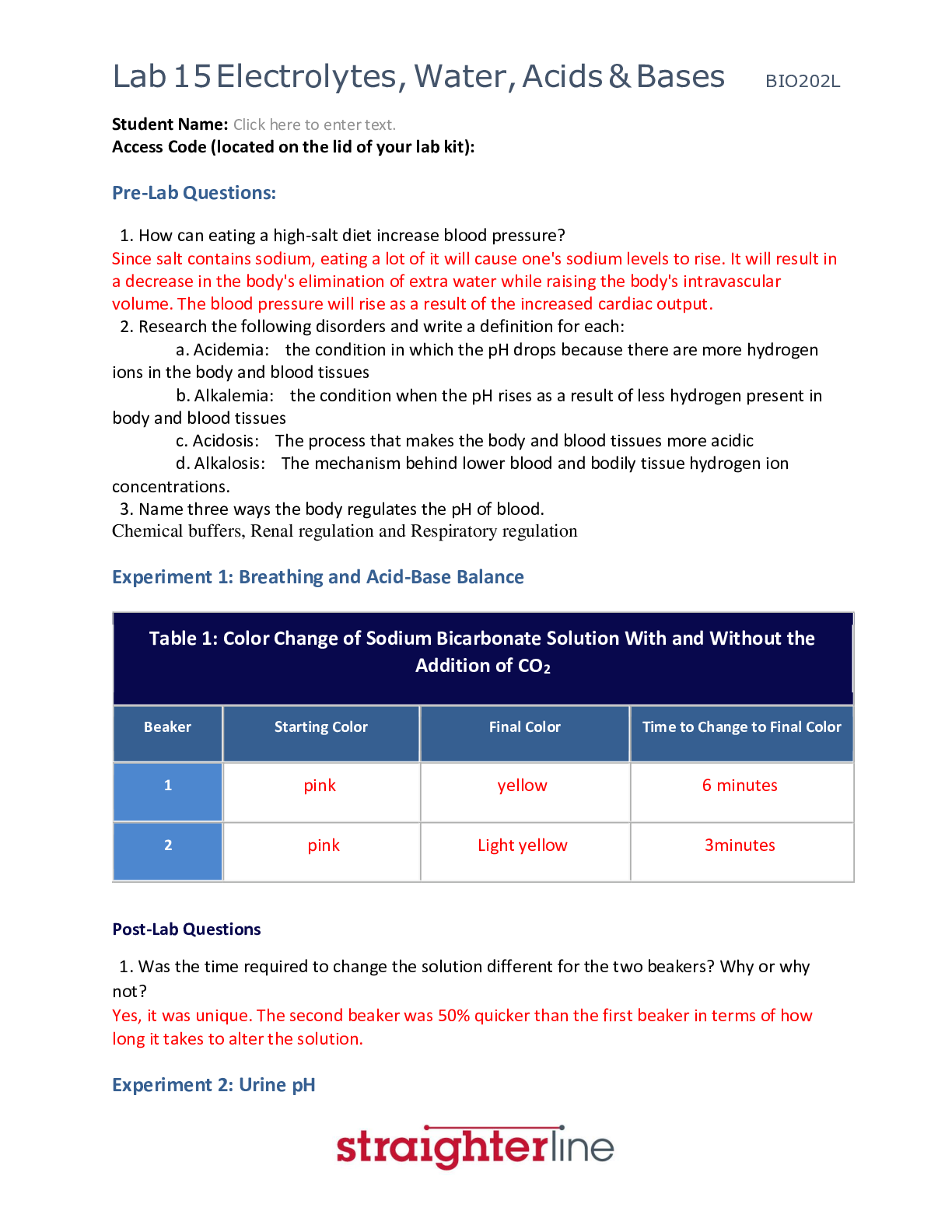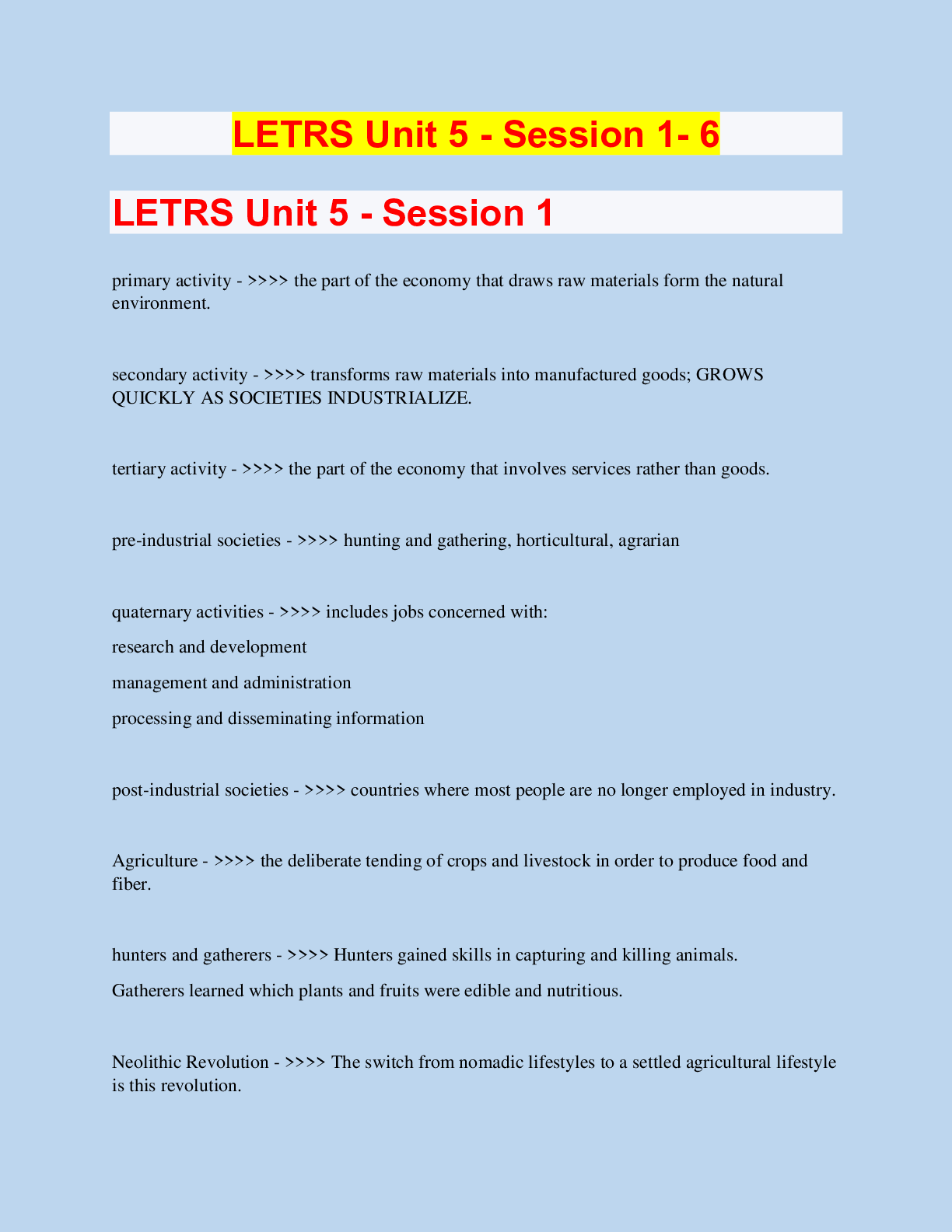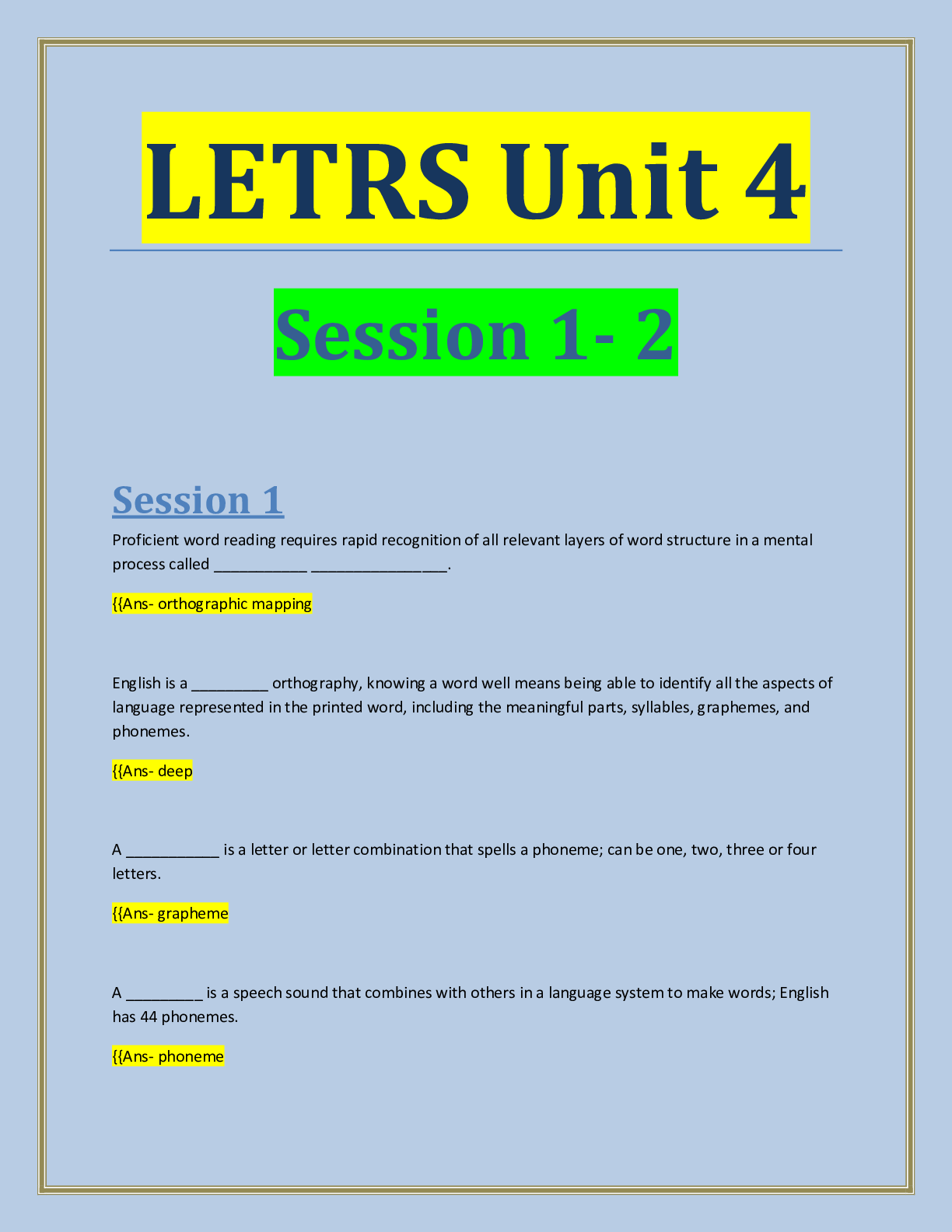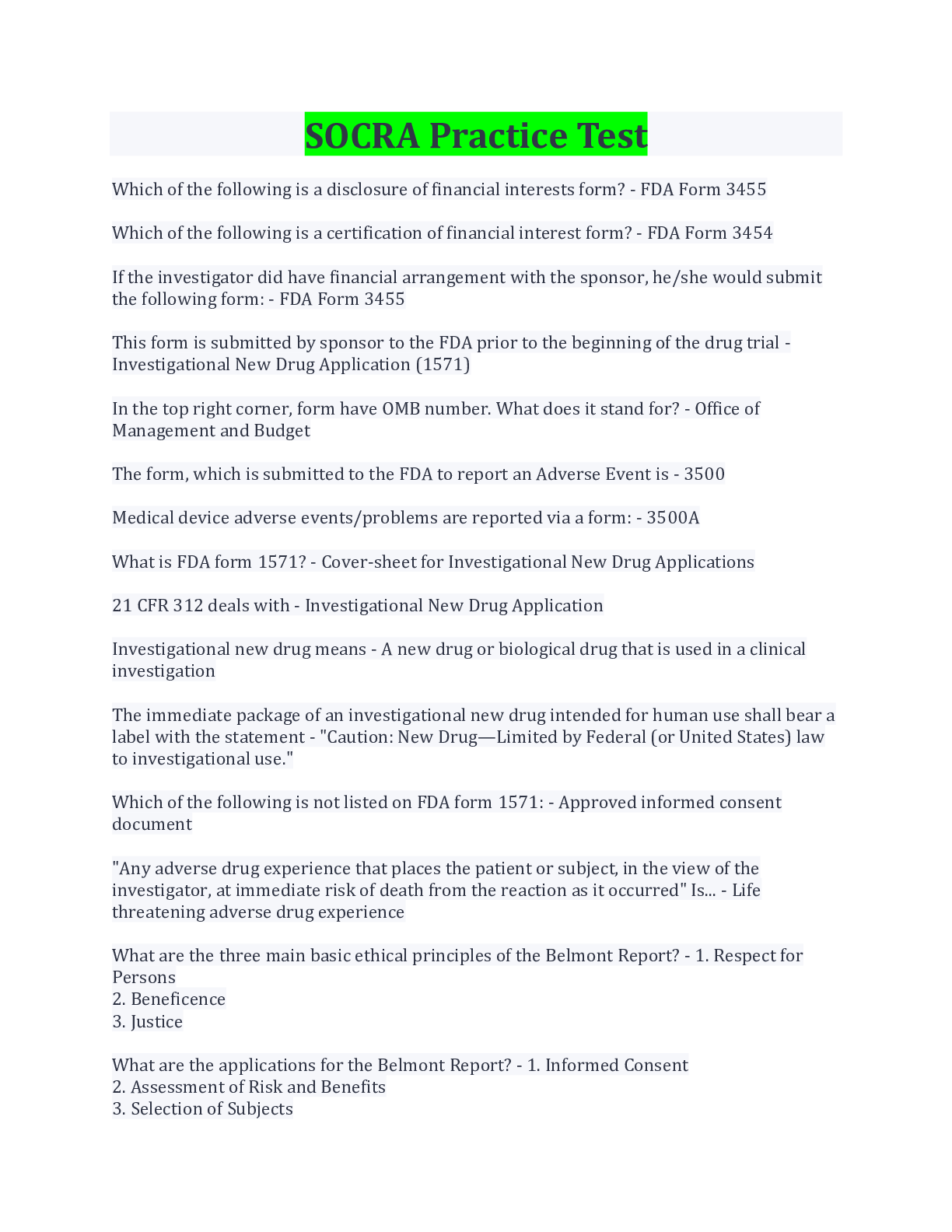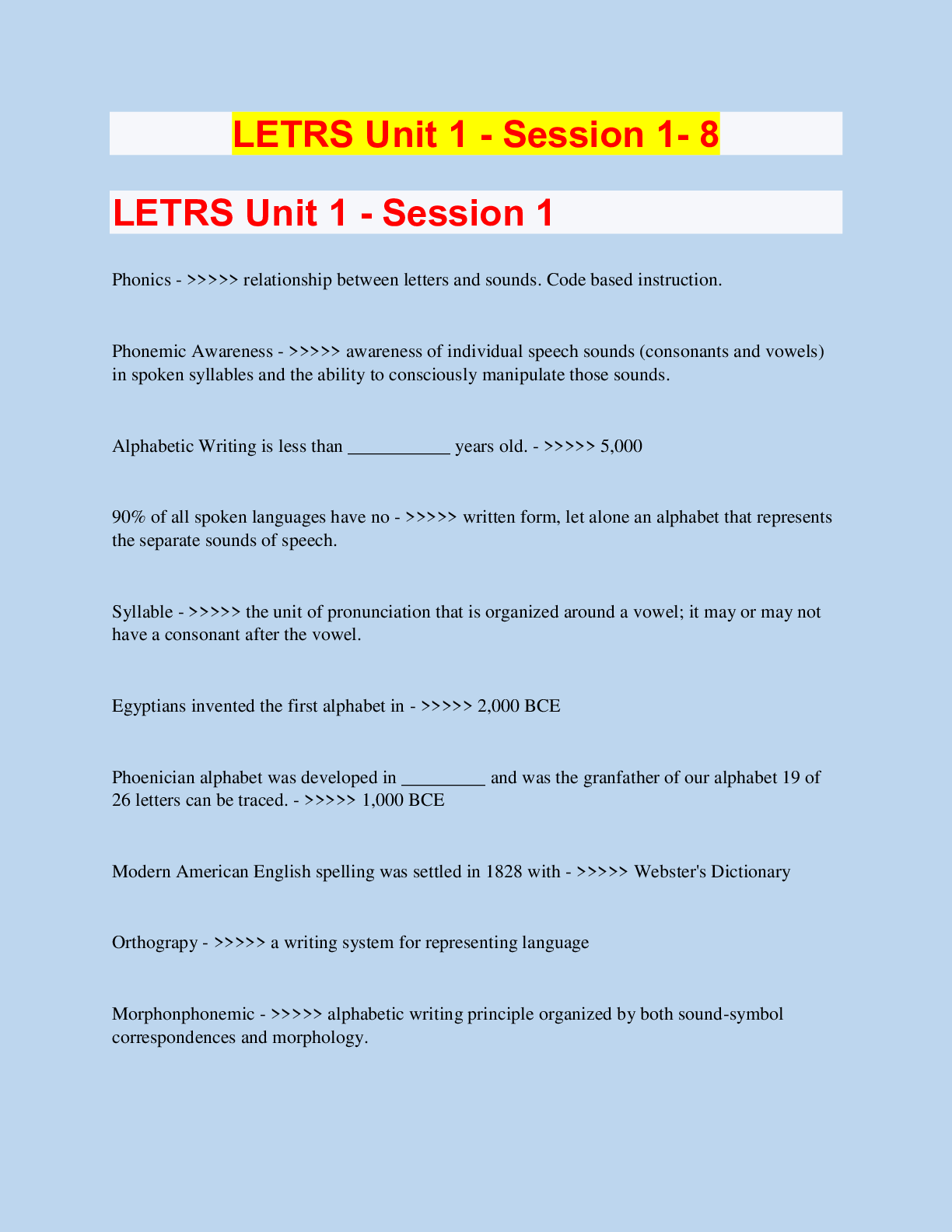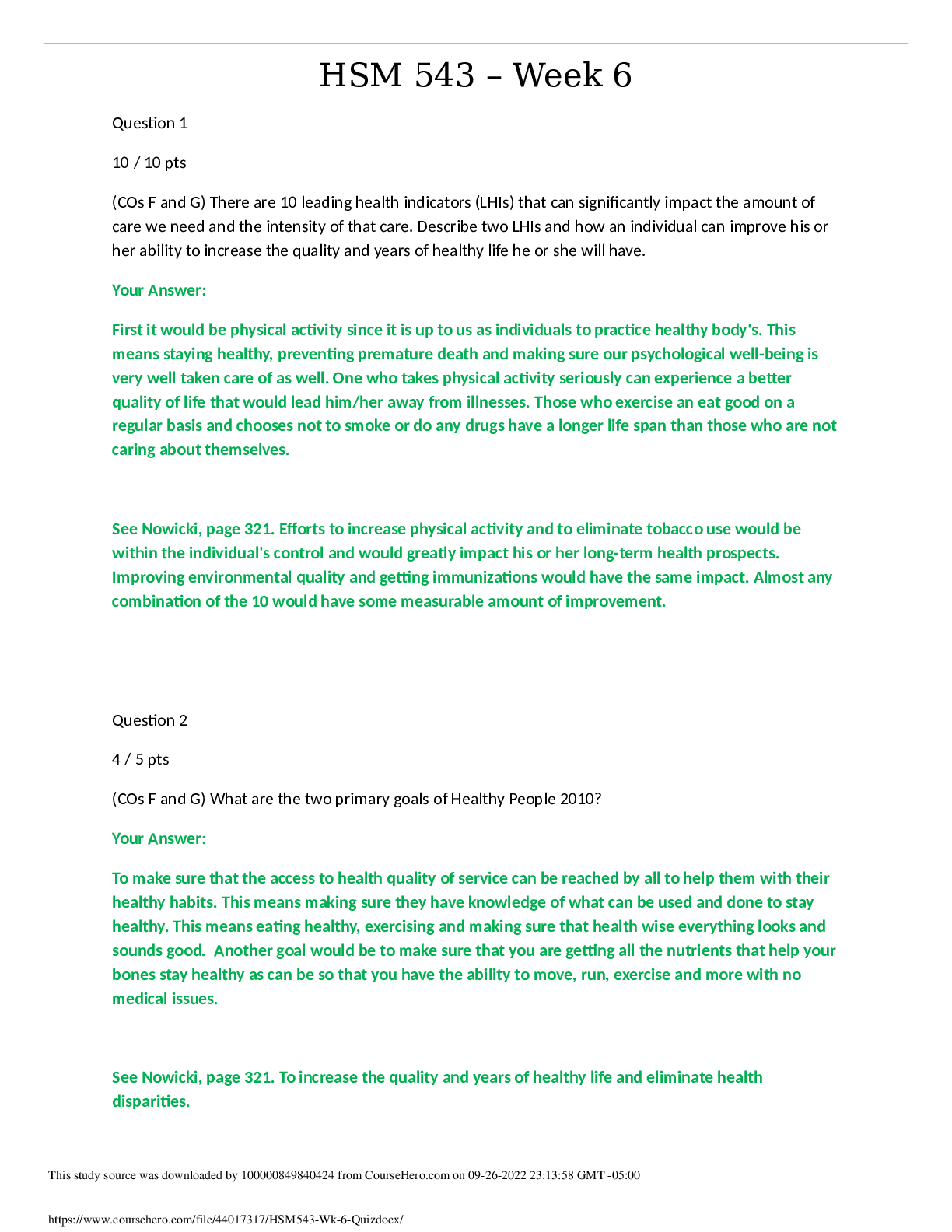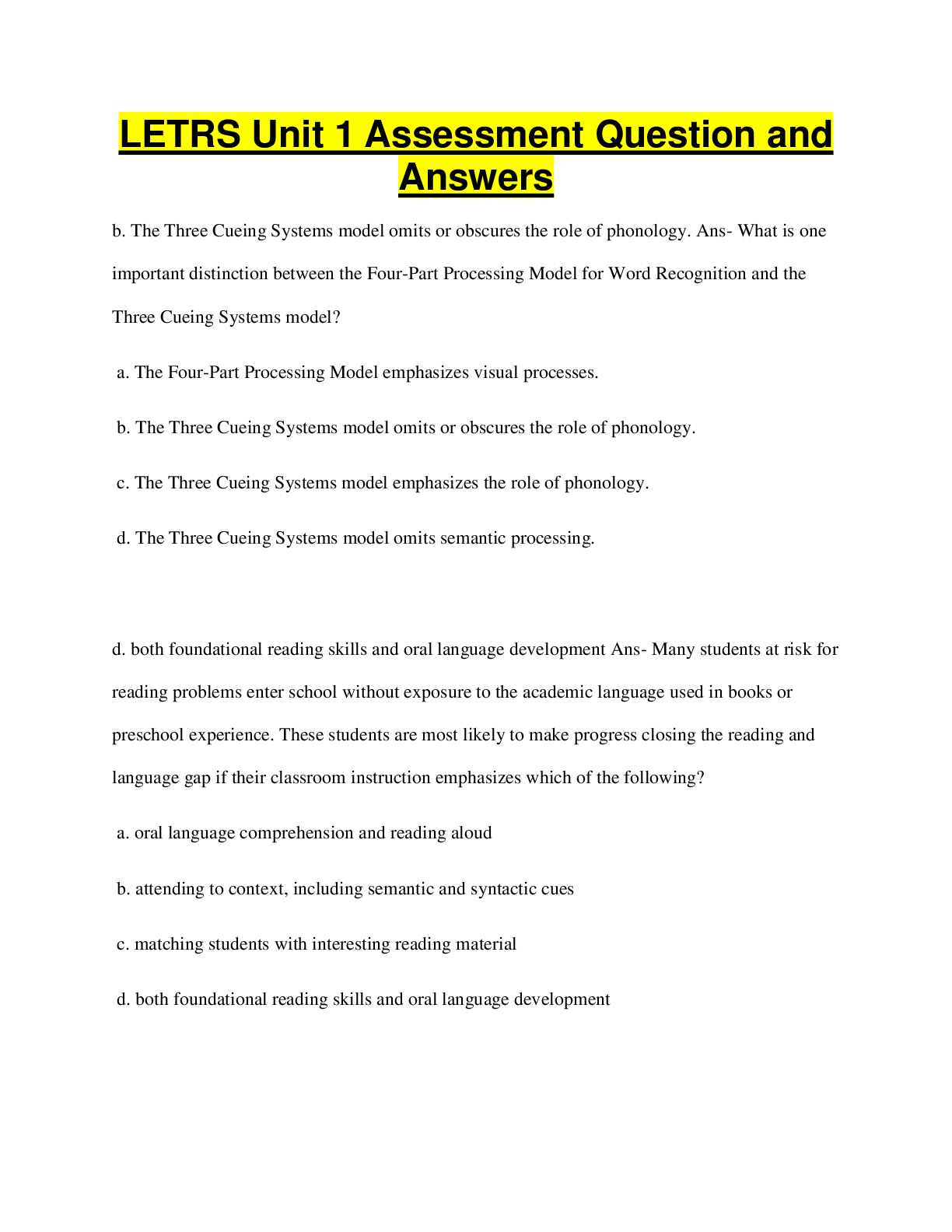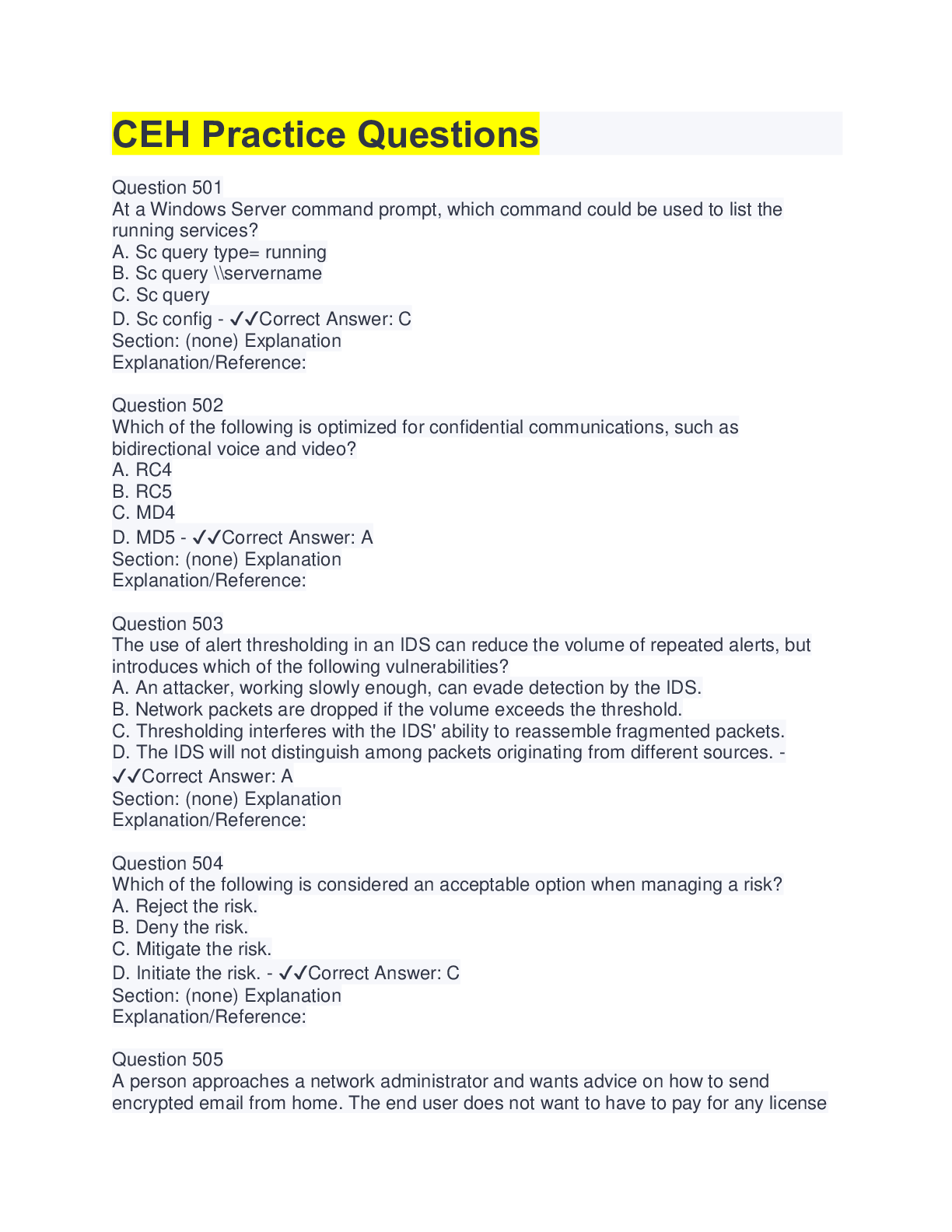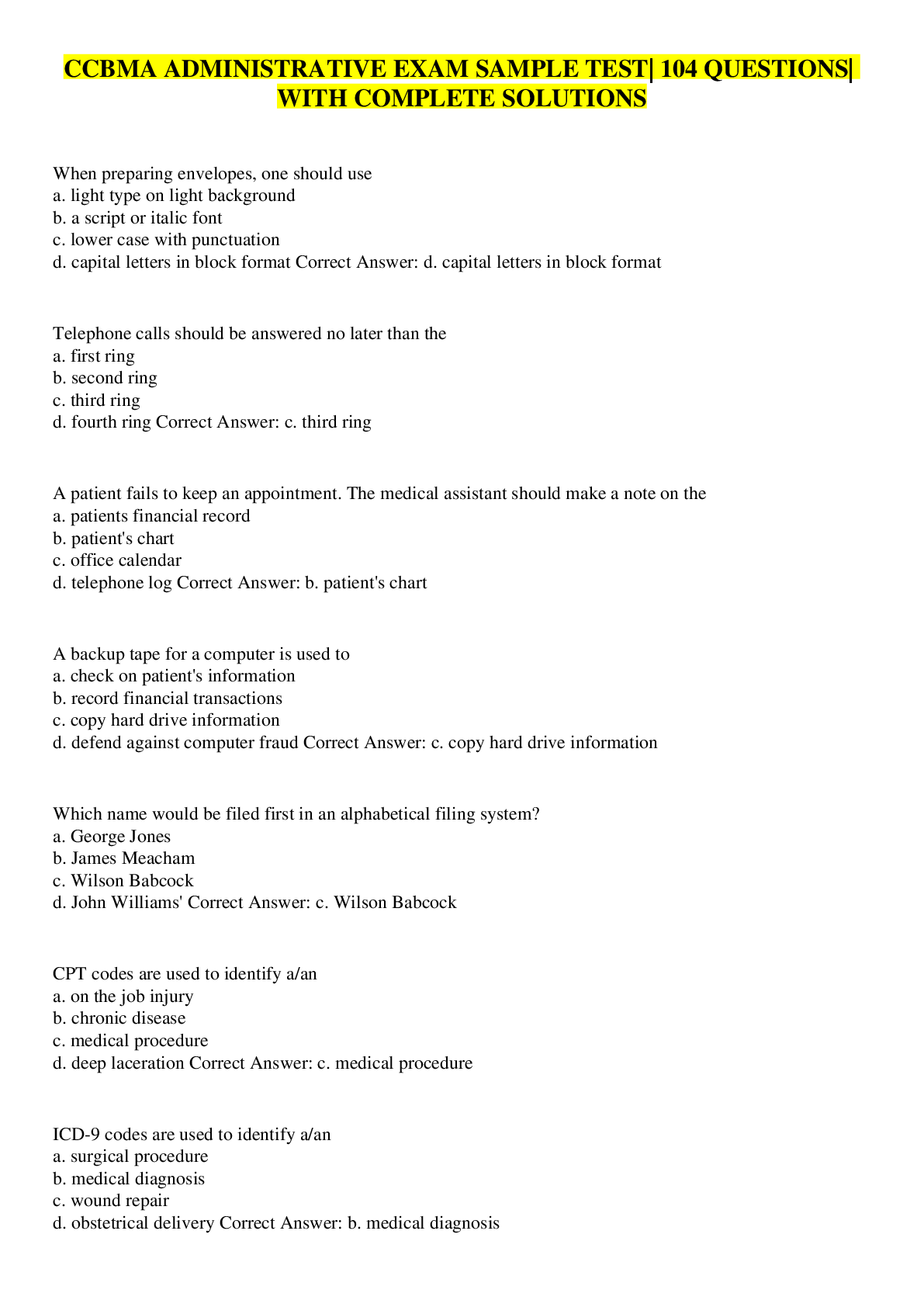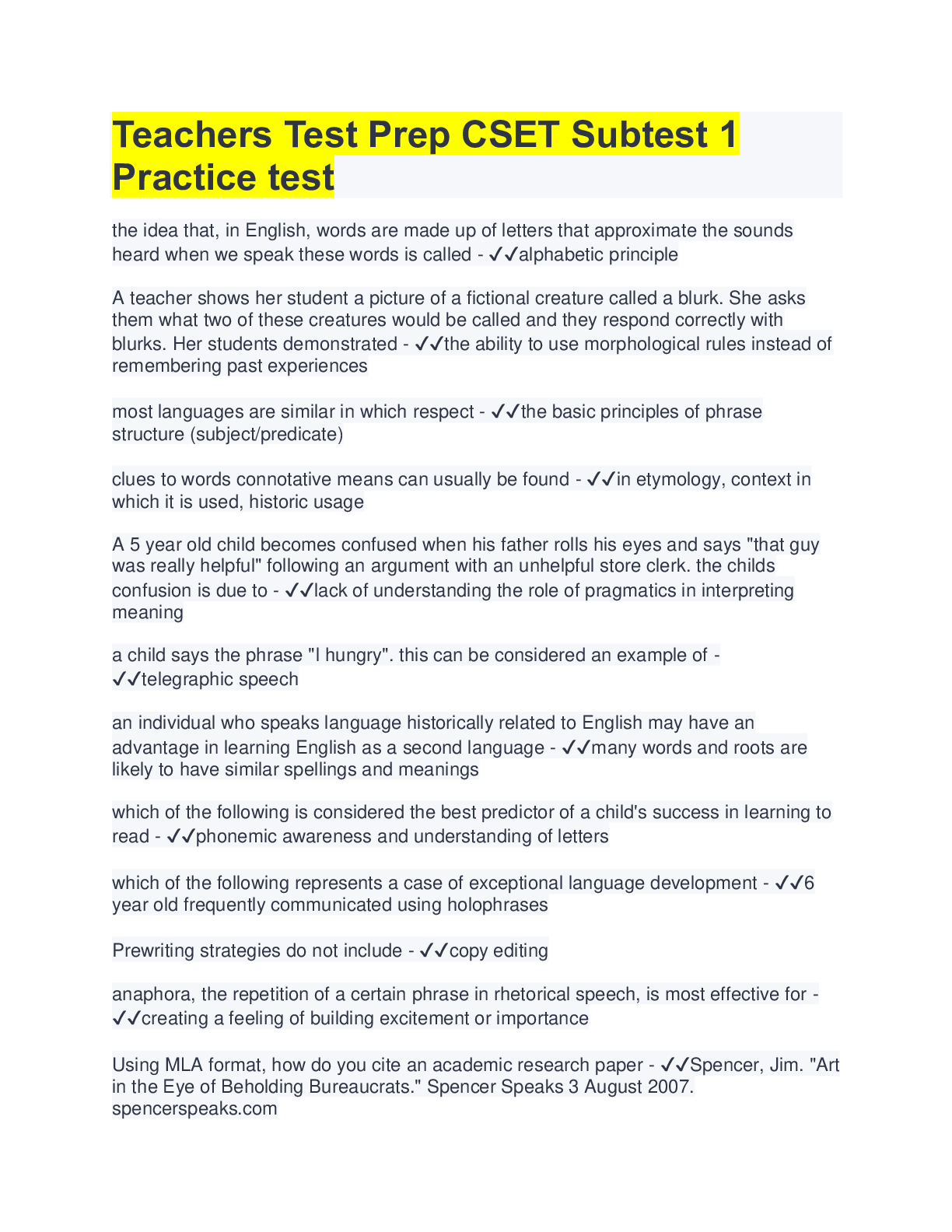NURS 4010 CAT VERSION 1 | 100% CORRECT
Document Content and Description Below
NURS 4010 CAT VERSION 1 1. At a routine prenatal visit, a client at 24-weeks gestation complains of nasal stuffiness and occasional nosebleeds. Which hormone is responsible for these changes? A. Hum... an chorionic gonadotropin. B. Progesterone. C. Relaxin. D. Estrogen. 2. A client who has localized eczematous eruptions on b oth hands is diagnosed as having contact dermatitis. What instruction should the nurse include in this client's discharge teaching plan? A. Wear latex gloves whenever outdoors. B. Apply an oil-based ointment to the affected areas. C. Take prescribed antihistamine near bedtime. D. Soak hands in warm soapy water three times a day. 3. While transcribing a new prescription, the nurse notes that the prescribed dosage is much lower than the recommended dosage listed in the drug reference guide. Which client data supports the dosage reduction? A. Decreased serum creatinine B. Increased serum protein. C. Increased liver enzymes. D. Prolonged prothrombin time. 4. The nurse assigns an unlicensed assistive personnel (UAP) to take the vital signs of a client who is positive for Human Immunodeficiency Virus (HIV). What protective apparel should the nurse counsel the UAP to wear when carrying out this assignment? A. None. B. Gown, gloves, mask. C. Gloves and mask. D. Gloves only. 5. A client with Guillain-Barre syndrome requires a tracheostomy and mechanical ventilation due to the progression of the disease. What nursing intervention is most helpful in aiding this clinet to communicate with the staff and family? A. Speak slowly and disntinctly while in direct view of the client. B. Teach the client to point to a letter board word chart to communicate needs. C. Provide the client with a pencil and tablet of paper. D. With the client, develop a system of eye blinks to communicate "yes" or "no." 6. A client with peptic ulcer disease (PUD) is admitted to the emergency room complaining of sudden severe upper abdominal pain. Assessment indicates an extremely tender and rigid abdomen, B/P of 90/60 mmHg, and pulse of 110 beat/minute. The emergency department nurse should anticipate implementation of which intervention? A. Preparing the client for emergency abdominal surgery. B. Infusing the proton pump inhibitor Protonix intravenously. C. Administering an iced saline lavage. D. Inserting a nasogastric tube to decompress the bowel. 7. Which finding should the nurse expect a client to exhibit who is newly diagnosed with fibromyalgia? A. Recent joint trauma. B. Disruption in sleep patterns. C. Unexplained weight gain. D. Itching and rash. 8.A male client with diabetes mellitus reports that he has had trouble following his diet, and the result of his fasting blood glucose test is 90 mg/dl. What action should the nurse implement first? A. Obtain a urine specimen from the client to test for ketonuria. B. Assure the client that his diabetes control is within normal limits. C. Schedule the client to attend classes about diet management. D. Review the findings of his glycosylated hemoglobin test. 9. A multipara postpartum client complain intense cramping while breastfeeding. Whar instruction should the nurse provide to the client? A. Change the infant's position during the next feeding. B. Void and completely empty bladder before each feeding. C. Take a prescribed analgesic an hour prior to breastfeeding. D. Drink two glasses of water 30 minutes prior to breastfeeding. 10. A nurse is preparing to teach the parents of a child who had a surgical repair of myelomeningocele how to change an occlusive dressing on the child's back. Which statement by the parents indicates that they understand this procedure? A. "We should rapidly remove the tape from the edges of the dressing when changing it." B. "The dressing should be wetted periodically to keep the skin incision moist." C. "The dressing will help dry the sutures for ease of removal." D. " The purpose of the dressing is to protect the incision from fecal contamination." 11. While the nurse is preparing to administer a high volume saline enema to a male client, the client appears anxious and states that he is not able to turn on his right side without help because of a recent stroke. What action should the nurse take first? A. Reassure the client that he can remain in any position of comfort during the enema. B. Assess the client's ability to independently turn to his left side. C. Instruct the client that the procedure will only last about ten minutes. D. Ask a UAP to assist the client to maintain a right lateral position. 12. The nurse notes that a client is experiencing supraventricular tachyacardia (SVT). Which action should the nurse implement? A. Assess the client's heart sounds and vital signs. B. Call a code and start CPR immediately. C. Prepare to administer adenosine, an antidysrhythmic. D. Place a crash cart at the client's bedside. 13. A client is receiving an IV infusion of regular insulin, 50 units in 100 ml of normal saline at 4 units/ hour. The nurse should program the infusion pump to deliver how many ml/hour? (Enter numeric value only.) 8 mL/hour 14 A client takes dronedarone (Multaq) 400 mg PO twice daily is admitted with chest pain and shortness of breath. The nurse should withhold the Multaq if the client manifests which finding? A. Three premature ventricular beats/minute. B. QTc interval less than 500 milliseconds. C. Respiratory rate greater than 30 beats/minute. D. Palpable radial pulse less than 50 beats/minute. 15. A middle-aged client with complaints of chest pain radiating into his jaw is en route to the hospital via ambulance. Oxygen was started, threee nitroglycerin sprays of 5 minute intervals were administered, with no pain relief, and an IV was initiated. The cardiac monitor indicates normal sinus rhythm. On arrival at the Emergency Department, which intervention should the nurse implement first? A. Prepare for defibrillation or cardioversion. B. Inject 5,000 units heparin subcutaneously C. Obtain a 12 lead EKG. D. Administer a chewable aspirin 325 mg. 16. The nurse is planning a fall prevention program for the residents at a long-term care facility. Which intervention is most important in providing a safe environment? A. Encourage clients to wear rubber-soled shoes. B. Accompany residents older than 80 years during ambulation. C. Apply a vest restraint prophylactically to confused residents. D. Leave the hall lights on during the night. 17. For a client who has been receiving linezolid (Zyvox) for two weeks to treat an MRSA- infected wounds, what finding requires the most immediate action by the nurse? A. Ecchymosis B. Insomnia C. Tongue discoloration D. Vaginal discharge 18. The unlicensed assistive personnel (UAP) caring for a postoperative client reports to the charge nurse that the client is not using the incentive spirometer effectively. What action should the charge nurse implement? A.Schedule time later in the morning to review the use of incentive spirometer with the client. B. Ask the practical nurse assigned to care for the client to review the use of spirometer with the client. C. Encourage the UAP to demonstrate the effective use of the incentive spirometer to the client. D. Advise the UAP that the respiratory therapist is responsible to supervise the client's use of the spirometer. 19. During discharge teaching the mother asks why her premature infant should get monthly Synagis (Palivizumab) injections. The nurse's response should be bsed on what information? A. Monthly injections promote normal neurological and physical development. B. This drug protects the premature infant from respiratory syncytial virus (RSV) C. These injections prevent retinopathy of prematurity caused by high levels of oxygen. D. This medication provides surfactant, which helps the lungs mature more quickly, 20. In preparing assignments for the shift, which client is best for the charge nurse to assign to a practical nurse? A. A client with panreatic cancer who is experiencing intractable pain. B. An older client who fell yesterday and is now complaining of diplopia. C. An adult newly diagnosed with Type 1 diabetes and high cholesterol. D. An elderly client with Alzeimer's disease complicated by dysphagia. 21. The RN is in charge of a 20-bed surgical unit and is preparing assignments for the shift. Which nursing task should be assigned to the LPN? A. Administer a unit of blood to a client who has decreased hemoglobin and hematocrit. B. Take the routine vital signs on a client who just returned from surgery. C. Teach a client who has a new sigmoid colostomy how to irrigate the colostomy. D. Administer a pain medication to a client who had a bowel resection yesterday. 22. Following the administration of total parenteral nutrition (TPN) via a central line to a client diagnosed with inflammatory bowel disease (IBD), the nurse should expect what outcome? A. Afebrile with no purulent drainage from catheter site. B. Hydration as evidenced by tented skin turgor. C. A weight loss of 6 pounds within two weeks. D. A negative nitrogen balance during TPN administration 23. What is the most important primary preventative measure the nurse can emphasize as a means of reducing the risk of developing acute glomerulonephritis in the general population? A. Encourage all persons to have a yearly physical with urinalysis B. Teach all females to seek medical attention for urinary tract infections. C. Use good handwashing techniques to prevent throat and skin infections. D. Eat a low salt diet and monitor the blood pressure frequently. 24. The culture and sensitivity report for a client who has been receiving a broad spectrum antibiotic indicated that the bacteria is resistant to the currently prescribed medication. What action should the nurse implement in response to this finding. A. Notify the lab of the need for drug peak and trough levels B. Determine if the white blood cell count has increased. C. Administer the next scheduled dose of the antibiotic. D. Assess the oral mucosa for signs of superinfection. 25. When the healthcare provider calls to check on the status of a client with congestive heart failure who was given IV furosemide (Lasix) four hours ago, the nurse reports that the client has bibasilar crackles. What additional information is most important for the nurse to report to the healthcare provider? The client: A. is taking ice chips B. is receiving intravenous fluids at 125 ml/hour C. is receiving 50% oxygen per venturi mask D. has had a urine output of 600 ml the past four hours. 26. In caring for a client who is receiving peritoneal dialysis, the nurse should be alert for what complications? A. Clear dialysate drainage and burning on urination. B. Abdominal pain, tenderness, and rigidity. C. An occluded vascular access device and flank pain. D. Increased serum albumin level, decreased BUN, and increased hematocrit. 27. The home care nurse observes an older client place the walker in front of the chair for support upon standing. What action should the nurse take? A. Observe the client's strength and balnce as she arises. B. Instruct the client to use the arms of the chair for support. C. Encourage the client to stand upright independently. D. Apply a gait belt to assess the client out of the chair. 28. An adult client being admitted to the psychiatric unit with a diagnosis of bipolar disorder arrives in an elated state. What is the best room assignmenrt the nurse can make for this client? A. A room that contain very little furniture B. A quiet room awat from the nurse's station C. A room that has at least two other clients assigned to it D. A bright-colored room located near the recreation room. 29. The nurse plans to place a sensor for a pulse oximeter. Which placement ensures the best measurement of oxygen saturation? A. Right upper extremity with 2+ pitting edema B. Left upper extremity with capillary refill > 3 seconds C. Left lower extremity with a 3+ dorsalis pedis pulse D. Right lower extremity with a 1+ pedal pulse. 30. A client at 8 weeks gestation is told her hemoglobin is 9.5 mg/dl. Which nursing intervention has the highest priority? A. Explain tha this is a normal finding in early pregnancy. B. Instruct the client to eat a well-balanced diet. C. Probvide the client with a list of foods high in iron D. Obtain a prescription for an iron supplement. 31. The nurse is performing a routine well-child exam on a 5 year-old. While palpating the lymph nodes, the nurse feels several 0.5 cm nodes in the cervical area that are round, mobile, non-tender, and non warm to the touch. What do these findings most likely represent? A. An indicator of early stage mumps B. An expected finding for a well child of this age. C. A sign of acute lymphadenitis D. An abnormal finding in need of further investigation 32. An 86-year old female client complains to the nurse that she does not like to eat as much she used to because things taste differently to her now that she is olde. The nurse's response should be based on which fact? A. Taste sensation decreased in older adults because of diminished gastric secretions B. Older people often use poor taste sensation as an excuse to avoid eating foods they do not like. C. Poorly prepared meals and eating alone are the usual causes of a decreased appetite in older adults. D. A loss of appetite often occurs in older adults as a result of a decreased sense of smell. 33. The nurse is conducting health assessments. Which assessment finding increases a 56 year olf woman's risk for developing osteoporosis? A. Cigarrette smoking B. Family history of coronary heart disease C. Use of birth control pills until age 45 D. Obesity 34.The nurse is developing a teaching plan for a client with varicose veins. What instruction should be included in this plan? A. Soak feet in warm water when fatigues. B. Use elevators, instead of stairs C. Walk several minutes every hours D. Cross legs at the thighs only 35. The charge nurse in a critical care unit is reviewing client's conditions to determine who is stable enough to be transferred. Which client status report indicates readiness for transfer from the critical care unit to a medical unit? A. Myocradial infraction with sinus bradycardia and multiple ectopic beats B. End- stage renal failure with creatinine of 2.5 mg/dl and urinary output of 10 ml/hr C. Pulmonary embollus with an intravenous heparin infusion and new onset hematuria D. Adult respiratory distress with pulse oximetry of 88% 36. A male client sitting in his room tells the nurse," The CIA put this transistor right here under my left ear. They are transmitting messages. Can't you hear them? They're so loud they scare me." Which response is best for the nurse to provide? A. " What is the message telling you." B. " How long have you been hearing the messages." C. " The messages scare you?" D. "Do you think others hear the messages?" 37. In caring for a client with laryngitis, the nurse observes that the client has a frequent, dry cough while conversing with family members. The client also reports experiencing dysphagia due to pain. What action should the nurse implement? A. Instuct the client to restrict conversations B. Encourage the client to use the incentive spirometer C. Apply a cold compress to the client's throat. D./ Advise the client to restrict intake of oral liquids. 38. A male college student returns to the student health clinic one week after receiving a positive mono spot test for mononucleosis and requests a prescription for amoxicillin (Amoxil, Polymox). He is afevrile and complains of fatigue, a sore throat, dysphagia, and extremely swollen glands. What response should the nurse provide? A. Inform the healthcare provider of the client's request for the prescription. B. Explain that no effective treatment is available for these symptoms. C. Emphasize the need to avoid contact sports for at least two weeks. D. Clarify that these symptoms will not respond to antibiotic therapy 39. In establishing goals for the client's plan of care, which information is most important for the nurse to consider? A. Nursing diagnosis B. Evaluation strategies C. Clusteres assessment data D. Planned interventions 40. The nurse includes the diagnosis, "Impaired mobility related to weaknedd and fear of falling" in the plan of care of a postoperative cilent. Which goal should be added to the care plan to address this diagnosis? The client will: A. report any weakness to the nurse B. be instructed in safety measures C. not fall during the hospital stay D. demonstrate increased mobility 41. A client is receiving a continuous half strength tube feedinf at 50 ml/hour. To prepare enough of the solution for eight hours, how many ml of full strength feeding will the nurse need? (Enter numeric value only.) 200 mL 42. A client is receiving an IV of Heparin Sodium 20,000 Units in 5% Dextrose Injection 500 ml at 27 ml/hr. The nurse wants to verify that the client is receiving the prescribed amount of heparin. How many untis is the client receiving every hour? (Enter numeric value only.) 1080 units 43. The healthcare provider prescribes fluoxetine (Prozac) for a client with major depressive disorder. Which instruction should the nurse include in this client's medication teaching plan? A. Avoid eating avocados and drinking red wine B. Expect to feel more tired and lethargic C. Dry, cold skin is a common side effect D. Take the medication in the early morning 44. A client with hemothorax has a chest tube in the fourth intercostal space connected to suction at 20 cm H2O pressure. Four after insertion, which client outcome should the nurse consider to be within normal limits for this client? A. No bubbling in the suction chamber of the Pleuravac B. The dry gauze dressing over the insertion site is clean and intact C. Serous fluid in the drainage chamber of Pleuravac. D. Fluctuation with respiration in the water-seal chamber of the Pleuravac 45. The nurse assess a client who is immunosuppressed and is diagnosed with a respiratory infection. The client has respirations at 20 breaths/minute, pulse oximetry of 95%, clear bilateral breath sounds, and is afebrile with no productive cough. Which nursinf diagnosis should the nurse include in client's plan of care? A. Risk for activity intolerance B. Impaired gas exchanged C. Risk for ineffective airway clearance D. Impaired tissue perfusion 46. After diagnosis and initial treatment of a 3-year old child with cystic fibrosis, the nurse provides home care instructions to the mother. Which statement by the child's mother indicates that she understands home care treatment to provide pulmonary function? A. "Cough suppressants can be used four times a day." B."Chest physiotherapy should be performed at least twice a day." C. "Activities should be planned to avoid physical exertion." D. "The oxygen should be kept at 4 to 6 L/minute." 47. A male client who takes carvedilol (Coreg) 25 mg twice daily is admitted with atrial flutter. His ejection fraction (EF) is 30%, his blood pressure is 190/86, and he has a history of type 1 diabetes mellitus. The healthcare provider prescribes dronedarone (Multaq) 400 mg PO twice daily. Which assessment finding warrants immediate intervention by the nurse? A. Chronic dermatitis B. Abdominal pain C. Sever headache D. Sinus bradycardia 48. Two nurses were in a conflict related to weekend scheduling, but after a discussion, report that they resolved the issue between themselves. Which question should the nurse- manager ask to evaluate the quality of the decision-making process in this conflict resolution? A. "How much cooperation had been generated?" B. "Has understanding been increased between the two of you?" C. " How practical and realistic are the decisions that have been made?" D. "Are you both willing to work together?" 49. Which explanation of autonomic cardiac regulation mediated by sympathetic innervation is correct? A. Sympathetic activatin decreased dromotrophy by lowering conduction. B. Sympathetic activation boosts K+ efflux and increases the inotropic effect. C. Increased Na+ influx with sympathetic stimulation reduces pacemaker. D. Increased Ca+ influx with sympathetic stimulation raises the heart rate. 50. It is most important for the nurse to use an IV pump and/ or Buretrol, an in-line volume control device, when initiating IV therapy for a client following which surgical procedure? A. Femoral popliteal bypass B. Colostomy C. Craniotomy D. Total hip replacement 51. An adult client receives a prescription for permethrin (Acticin Cream 5%) to treat an infestation of scabies. The nurse instructs the client to massage the cream into the skin from the head to the soles of the feet, avoiding the eyes. Which additional instruction should the nurse provide? A. Remove the cream from the skin immediately is pruritis occurs, B. Shower or bathe 8 to 14 hours after treatment to remove cream. C. Avoid areas between fingers and toes during application D. Reapply cream in seven days to prevent reinfestation. 52. When assessing a client at 32-weeks gestation, the nurse determines that her deep tendon reflexes (DTRs) are 4+. What action should the nurse take first? A. Notify the healthcare provider B. Assess the client for pitting edema C. No action is required since this is a normal finding D. Determine the client's blood pressure 53. The nurse notices a reddened area on the coccyx of a wheelchair-bound client. Which intervention should the nurse implement? A. Encourage the client to shift weight while sitting. B. Ask the team leader to document the assessment findings C. Carefully rewash the site and apply Duoderm patch D. Provide a donut-shaped cushion for the client to use. 54. A client with a general anxiety disorder is pacing the hallway. The client tells the nurse," My heart us just racing and sometimes it feels like it's fluttering. I'm feeling short of breath and dizzy." What action should the nurse implement first? A. Administer an anti-anxiolytic B. Obtain the client's vital signs C. Escort the client to a quiet room. D. Initiate a diversionary activity 55. A client with general anxiety disorder is pacing the hallway. The client tells the nurse, "My heart is just racing and sometimes it feels like it's fluttering. I'm feeling short of breath and dizzy." What action should the nurse implement first? A. Adminster an anti-anxiolytic B. Obtain the client's vital signs C. Escort the client to a quiet room D. Initiate a diversionary activity. 56. A male client with gastroesophageal reflux (GERD) tells the clinic nurse that he continues to have epigastric distress, even after starting lansoprazole (Prevacid) Delayed Release capsules last week. Which action should the nurse take first? A. Ask the client about the usual administration time. B. Determine if the client is chewing or crushing the capsule contents C. Recommend that the client remain upright after meals for 30 minutes. D. Encourage mixing the granules with appplesauce, 57. The nurse is teaching a client newly diagnosed with diabetes mellitus the signs of hypoglycemia. What symptom should be included in the description of early signs of hypoglycemia? A. Difficulty swallowing B. Poluria C. Tremors D. Bradycardia 58. The nurse should question the use of dopamine, and adrenergic agonist, for a client with which assessment finding? A. Currently receiving a loop diuretic B. Experiencing ventricular fibrillation C. Blood pressure if 90/60 D. Is taking a tricyclic antidepressant 59. Following two defibrillation shocks, the client's ECG continues to indicate ventricular fibrillation (VF). Which intervention should the nurse implement next? A. Resume CPR immediately B. Perform the third defribrillation shock. C. Obtain an arterial blood gas sample. D. Administer an IV bolus of epinephrine 60. A client with a prescription for "do not resuscitate " (DNR) begins to manifests signs of impending death. After notifying the family of the client's status, what priority action should the nurse implement? A. Assess the client's need for pain medication B. Notify the chaplain of the client's status C. Report the client's status to the healthcare provider D. Document the client's signs of impending death. 61. Which technique should be used to obtain a sterile urine specimen using a straight catheter? A. Discard the first specimen, clamp the catheter, then collect the next specimen. B. Drain the urine from the catheter into a sterile container C. Use a sterile syringe to obtain the specimen from the port. D. Drain the urine from the collection bad into a sterile container. 62. The nurse is caring for a client who is admitted to the telemetr unit for complications related to a myocardial (MI) that occurred 4 days ago. A 12 lead electrcardiogram (ECG) shows right axis deviation and poor R wave progression. Which assessment findings suggest that the client is at risk for right ventricular hypertrophy? A. Generalized fatigue, dizziness, swollen ankles B. Severe chest pain and shortness of breath C. Nausea, vomiting, and generalized edema D. Sharp, non-radiating chest pain and nausea 63. The nurse plans to place a sensor for a pulse oximeter. Which placement ensures the best measurement of oxygen saturation? A. Right upper extremity with 2+ pitting edema B. Right lower extremit with a 1+ pedal pulse C. Left upper extremity with capillary refill > 3 seconds D. Left lower extremity with a 3+ dorsalis pedis pulse 64. The nurse should question a prescription for docusate sodium (Colace) for a client with which problem? A. First day post myocardial infarction B. Abdominal pain of unknown etiology C. Two days following a knee replacement D. History of liver disease 65. A client with an anterior wall myocardial infarction is admitted to the intensive care unit with persistently low blood pressure. The nurse determines the client's pulmonary capillary wedge pressure (PCWP) is 28 mm Hg and systemic vascular resistance (SVR) is 2000 dynes/sec/cm5. Which classification of medication is likely to optimize the client's SVR? A. Adrenergic B. Vasodilator C. Diuretic D. Positive inotropic agent 66. The nurse is evaluating discharge teaching of an adolescent who had a long log cast applied in the emergency department. Which statement by the adolescent indicates an understanding of cast care? A. " I should wrap a cloth around a stick before using it to scratch under my cast." B. " I will not be able to take a shower until the cast is removed from my leg." C. " I will put adhesive tape around the edges of the cast if they become sharp." D. " If my toes are tingling I will elevate my leg above my heart, on several pillows." 67. Which technique should the nurse use to assess for manifestations of erythema infectiosum (fifth disease) in a 4 year-old? A. Auscultate breath sounds B. Observe physical appearance C. Visualize oropharynx D. Palpate lymph nodes 68. A client is taking cromolin sodium (Intal) Inhaler for chronic asthma. Which statement indicates the client understands the medication teaching? A. " I will have my liver enzymes checked monthly." B. " It is more important to take this medication with food." C. "I should keep my inhaler with me at all time." D. "I will not discontinue taking this medication abruptly." 69. A female client is admitted to the psychiatric department on an emrgency commitment. The client's husband asks the nurse, "What is going to happen to my wife? Can I take her home now?" Which information should the nurse provide? A. Discharge can be completed after arrangements with the business B. Emergency commitment extends to a maximum of 90 days. C. Hospitalization is mandated until a mental health court hearing is held. D. A pschiatric evaluation is required for continued hospitalization. 70. A client with a diagnosis of bipolar disorder is taking lithium and divalproex sodium (Depakote). In assessing this client, which symptom should the nurse report to the healthcare provider immediately? A. Recent significant hair loss B. Noticeable find hand tremors C. Describes having a dry mouth. D. Complains of blurred vision 71. The practical nurse (PN) reports the patterns of urinary frequency and volume for several clients. Which finding necessitates further assessment by the RN? A. Voiding 300 ml clear yellow urine q4h B. Voiding 50 ml cloudy urine every hour C. Total indwelling catheter output of 1800 ml in 24 hours D. 400 ml amber urine by straight catheter q6h 72. The mother of a child with cerebral palsy (CP) asks the nurse if her child's impaired movements will worsen as the child grows. Which response provides the best explanation? A. The most common permanent physical disabilit of childhood is CP. B. The outcome depends on the continued development of the brain lesion. C. The classifications of CP determines the severit of motor dysfunction D. The course of CP is variable but the brain damage is not progressive. 73. The nurse is discussing the use of isotertinoin (Accutane) with a 19-year old female client, who has been taking oral contraceptives for one year. The client agrees to use a second form of contraception while on the medication, and has had two negative pregnancy tests. What other instruction should the nurse provide regarding the use of Accutane? A. If depression occurs, the use of St. John's Wort is recommended. B. The medication must be taken with food to enhance absorption. C. Fluids should be limited to sips when swallowing this medication. D. Serum lipids should be evaluated at the beginning and end of treatment. 74. Which intervention is best for the nurse to implement for a client who is experiencing severe toe pain as the result of acute gout? A. Minimize calcium rich foods in diet B. Provide passive ROM to the foot and toes C. Place a foot cradle under the linen D. Apply anti-embolism stocking bilaterally. 75.Nursing assessment of a client with Type 2 diabetes reveals that the client is 5' 6" tall, weighs 238 lbs, works behind a desk all day, does not exercise, and smokes 2 packs of cigarettes daily. In planning care for this client, which intervention is most important for the nurse to implement? A. Discuss changing eating habits with a goal of losing 2 lbs/week. B. Instruct the client to decrease the number of cigarrettes smoke daily. C. Determine the client's feelings about being diagnosed with a chronic disease D. Encourage other family members to be tested for diabetes. 76. A woman who recently delivered a normal newborn calls the clinic crying and describes feeling overwhelmed and discouraged. Which information is most important for the nurse to obtain? A. Is there anyone with her at this time? B. Has she seen a mental health provider? C. Does she describe herself as depressed? D. How long has she been feeling this way? 77. An infant is admitted to the newborn nursery, and is believed to have Down syndrome. Which physical finding might the nurse expect to see? A. Maxillary hypoplasia B. Postual hypotonia C. Janeway spots on the palms D. Fusion of cranial sutures 78.The nurse is performing an admission physical assessment of a newborn who is small for gestational age (SGA). Which finding should the nurse report immediately to the pediatric healthcare provider? A. High pitched shrill cry B. Widened, tense, bulging fontanel C. Head circumference of 35 cm (14 inches) D. Heel stick glucose of 65 mg/dl 79. The nurse is caring for a yound adult male client with facial injuries resulting from a motor vehicle collision. Which client statement is indicative of the highest priority for nursing intervention? A. " I dont want my family and friends to see me looking like this." B. " I am not taking any more medication because the make my mouth dry." C. "I can't sleep through the night because I awaken with pain when I move." D. "My biggest fear is that this injury will cause me to lose my job." 80. The nurse notes that an elderly client who is receiving a continuous tube feeding is increasingly fatigued and confused. Which assessment is most important for the nurse to complete before notifying the healthcare provider? A. Bowel sounds B. Breath sounds C. Skin turgor D. Capillary refill 81. A client diagnosed with myxedema coma has assessed vital signs of: T 99.8F; P= 92 beats/minute; R= 22 breaths/minute, B/P 108/70 mmHg. Based on this information, what intervention should the nurse implement first? A. Monitor the vital signs q1h for the next 8 hours B. Notify the healthcare provider immediately C. Assess the client for presence of infection D. Encourage the client to use an incentive spirometer 82. Which type of therapeutic bath should the nurse recommend to a client who is complaining of pruiritus? A. An emollient bath B. An antibacterial bath C. A betadine bath D. A colloidal bath 83. A pregnant client begins to cry when the UAP tries to assist her in donning a hospital gown, and she refuse to remove an undergarment that is worn in her culture to preserve modesty. What should the charge nurse do first? A. Dertermine if continued wearing of the garment will compromise care. B. Incorporate individualized cultural care into the nursing plan of care. C. Discuss the importantce of respecting cultural beliefs with the UAP. D. Talk with the client to determine alternate means to preserve modesty. 84. The nurse is assessing a client following hemodialysis. What finding indicate that an expected outcome of dialysis was achieved? A. Decrease in BP B. Weight gain C. Hemoglobon WNL D. Increased urinary output 85. A nurse who is new to the pediatric unit is positioning a 6 month old for an injection of penicillin V (Pen V) in the dorsogluteal muscle. Which action should the nurse manager who is supervising this nurse take first? A. Demonstrate techniques for restraining the infant B. Review the correct landmarks before the site is injected C. Instruct the nurse to select another injection site D. Explan the correct procedure for giving the medication 86. In evaluating the effectiveness of a client's nocturnal sleep patterns, what question is best for the nurse to ask the client? A. " How often do you awaken during the night?" B. " Do you remember dreaming at night?" C. " How mant hours do you sleep each night?" D. " Do you feel rested in the morning?" 87. A nurse is taking a health history of a 46 year old male client who has smoked cigarettes for 30 years. He has had chronic bronchitis for the past 6 months. What statement best describes the rationale for obtaining information from the family as well as from the client? A. Poor oxygenation inhibits the clients memory and renders information unreliable. B. Client's tend to grow accustomed to their cough and underestimates their nicotene use. C. Including the family helps to ensure that the client will comply with the treatment regimen. D. Family members are usually more anxious than the client to get the physical problem resolved. 88. The nurse learns that a newly admitted adult client has a six month history of recurring somatic pain. During the admission interview, it is most important for the nurse to question the client about what problem? A. Nausea and vomiting. B. Episodes of tremors. C. Periods of restlessness. D. Feelings of depression. 89. A nurse seeks to alter a provision of a state's Nurse Practice Act regarding nurse-client ratios, which the nurse believes to be unsafe. What action is most likely to impact a ruling by the state's Board of Nursing? A. Send documentation of the problem to the American Nurses' Association B. Meet with the nurse's representative to the state legislature. C. Send an anonymous letter of concern to the local newspaper D. File a grievence at the medical center where the nurse is employed. 90. A Chinese-American client who just delivered a baby states that she will not be able to take the prescribed sitz baths to help heal her episiotomy incision because this will cause an unhealthy balance of cold and hot forces. When planning nursing care, what nursing diagnosis has the highest priority? A. Knowledge deficit related to healing process B. Noncompliance related to cultural diversity. C. Anxiety related to cultural diversity. D. Impaired tissue integrity related to episiotomy. 91. In evaluating a client's plan of care, the nurse determines that the goals were not achieved despite the implementation of the planned intervention. What should the nurse do next? A. Establish new priorities of care. B. Document that the care plan is invalid. C. Revise the nursing diagnosis. D. Modify any unrealistic expected outcomes. 92. An autopsy is needed based on what pathologic finding that supports the diagnosis of Alzeimer's disease? A. Thiamine deficiency alters short-term memory by short-circuiting neuron transmission in the cortex. B.An intracranial shift occurs due to the accumulation of venous blood below the dura mater. C. Amyloid B peptide neurofibrils in the neurons of the hippocampus prevent transmissions to the cortex. D. Cerebral cortex micro-hemorrhages and infarcts destroy motor and sensory functions. 93.The nurse is providing preoperative teaching to a client scheduled for vertical banding gastroplasty. In preparing the client for the immediate postoperative period, which interventions most important for the nurse to implement? A. Show the client a nasogastric tube and explain reasons for low intermittent suction. B. Suggest dietary selections of high protein liquids in the immediate postoperative period. C. Prepare for monitoring in the intensive care unit during the first postoperative day. D. Refer for psychological counseling to focus on altered body image and behavior modification. 94. A new mother asks the nurse if her newborn infant has an infection because the healthcare provider prescribed a blood test called the TORCH screen test. Which response is best for the nurse to offer response to this mother's inquiry? A. A positive antibody titer screens for exposure to infections that can cross the placenta. B. The TORCH test will culture teratogenic organisms contracted during pregnancy. C. Rising titers identify the etiology of certain neuro-sensory birth defects D. The test identifies the correct antibiotic to give the newborn for an infection. 95. The nurse is teaching a male client the self-care skills needed to deal with his newly diagnosed chronic disease, hypertension. Which straregy is most likely to promote the client's commitment to needed lifestyle changes? A. Schedule multiple teaching sessions for the client to demonstrate his psychomotor skills. B. Provide clearly written and easily understandable materials to reinforce the teaching session. C. Emphasize the risks associated with noncompliance to the treatment regimen. D. Help the client identify ways in which these skills can benefit his quality of life. 96. The nurse is assessing the nutritional status of several infants. Based on data obtained while taking a history, which infant's family will need additional nutrional guidance? A. A 10 month old who takes 40 ounces of formula. B. An 8 month old whose mother is starting to introduce formula in a cup C. A 12 month old whose mother is giving finger foods. D. A 6 month old whose diet includes rice cereal, fruit, and breast milk. 97. The nurse is caring for a client with a nasogastric tube. Which instruction should be given to the unlicensed assistive personnel (UAP) assisting the nurse? A. Clamp the nasogastric tube before giving any fluids by mouth B. Irrigate the nasogastric tube with normal saline if the tube becomes obstructed. C. Report any change observed in the appearance of the nasogastric drainage. D. Notify the nurse if the nasogastric tube suction is not working correctly. 98. A mother who is bottle feeding her baby develops breast engorgement. What is the best recommendation is the nurse to provide this client? A. Expose the breast to air. B. Apply warm packs to the breast. C. Wear a tight bra and avoid breast stimulation. D. Express some milk from the breast by hand. 99. What intervention is most important for the nurse to implement to reduce a client's risk for injury during the intraoperative phase of surgery? A. Monitor the clients blood pressure and temperature B. Teach the client about appropriate positioning techniques C. Ensure accuracy of sponge and instrument counts D. Ensure that the client's right to privacy is respected. 100. Assessment findings of a 4 hour old newborn include: axillary temperature of 97.9F, heart beats/ minute with a soft murmur, and irregular respiratory rate at 46 breaths/ minute. Base findings, what action should the nurse take? A. Place a pulse oximeter on the heel. B. Swaddle the infant in a warm blanket. C. Obtain a heel stick blood glucose level D. Document the findinsg in the record. 101. The nurse is planning to take the blood pressure of a client who has been admitted with possible myocardial infarction. How should the client's arm be positioned when the nurse takes the client's blood pressure at the brachial artery? A. Slightly above the level of the heart B. At a level of comfort for the client C. Below the level of the heart. D. At the level of the heart. 102. The nurse is reviewing the medical history of a client who is scheduled for pararhyroidecytomy, which disorder in the client's history is most likely to be impacted by this surgery? A. Osteoporosis B. Fibromyalgia C. Gout D. Diabetes insipidus 103. The nurse is preparing to administer an intramuscular injection in the ventrogluteal site of a client who weighs 80 kg. What size needle should the nurse select? A. 21-gauge, 1.5 inch needle B. 27-gauge, 5/8 inch needle C. 20-gauge, 3 inch needle D. 25-gauge, 1 inch needle 104. A client has severe bradycardia following the administration of metoprolol (Toprol XL). What medication should the nurse anticipate adminstering? A. Digoxin (Lanoxin) B. Naxolone (Narcan) C. Diltiazem (Cardizem) D. Atropine sulfate 105. The practical nurse (PN) reports the patterns of urinary frequency and volume for several clients. Which finding necessitates further assessment by the RN? A. Voiding 300 ml clear yellow urine q4h B. Voiding 50 ml cloudy urine every hour C. Total indwelling catheter output of 1800 ml in 24 hours D. 400 ml amber urine by straight catheter q6h. 106. The nurse should question a prescription for docusate sodium (Colace) for a client with which problem? A First day post myocardial infarction B. Abdominal pain of unknown etiology C. Two days following a knee replacement D. History of liver disease. 107. After diagnosis and initial treatment of a 3 year old child with cystic fibrosis, the nurse provides home care instructions to the mother. Which statement by the child's mother indicates that she understands home care treatment to promote pulmonary function? A. "Cough suppressants can be used four times a day." B. "Chest physiotherapy should be performed at least twice a day." C. " Activities should be planned to avoid physical exertion." D. "The oxygen should be kept at 4 to 6 L/minute." 108. A client is receiving an IV Heparin Sodium 20,000 Units in 5% Dextrose Injection 500 ml at 27 ml/hr. The nurse wants to verify the client is rreceiving the prescribed amounnt of heparin. How many units is the client receiving every hour? (Enter numeric value only.) 1080 units/hour 109. In caring for a client with laryngitis, the nurse observes that the client has a frequent, dry cough while conversing with family members. The client also reports experiencing dysphagia due to pain. What action should the nurse implement? A. Instruct the client to restrict conversations B. Encourage the client to use the incentive spirometer C. Apply a cold compress to the client's throat. D. Advise the client to restrict intake of oral liquids 110. In caring for a client who is receiving peritoneal dialysis, the nurse should be alert for what complications? A. Clear diasylate drainage and burning on urination B. Abdominal pain, tenderness, rigidity C. An occluded vascular access device and flank pain D. Increased serum albumin level, decreased BUN, and increased hematocrit 111. The nurse is interviewing a client with a history of COPD, who is dyspneic and has a respiratory rate of 36 breath/ minute. What nursing diagnosis has the highest priority? A. Alteration in body image B. Impaired verbal communication C. Knowledge deficit D. Ineffective individual coping 112. A female client complains that she cannot sleep, cries much of the day, her healthcare provider diagnoses her as depressed and prescribes monoamine oxidase inhibitor (MAOIs), In the teaching plan, what foods ahould the nurse instruct this client to eliminate? A. Fruits with high acidity such as grapefruit and oranges B. Cheese, beer, and avocados C. Salty foods such as chips, and chocolate D. Carbonate beverages., eggs, and alcohol. 113. Following a thoracentesis, what assessment finding indicates to the nurse that the client is experiencing a complication of this procedure? A. Asymmetry of respiratory movement B. Increased pulse rate and blood pressure C. Clear, watery mucus when coughing D. Inability to demonstrate the cough reflex. 114. When giving a cooling bath to reduce the fever of a 3 year old child, which action should the nurse include? A. Pour tepid water over the child's back and chest B. Stroke the child's abdomen with cooling lotion C. Apply an ice pack to the back of the child's neck D. Gently massage the arms and legs with rubbing alcohol 115. A client is receiving an IV infusion of regular insulin, 50 units in 100 ml of normal saline at 4 units/ hour. The nurse should program the infusion pump to deliver how many m/ hour? (Enter numeric value only.) 8ml/hr 116. A client with end stage renal disease (ESRD) is experiencing systemic pruritis. What metablic conditions are mild causes of the development of this system? A. Contact dermatitits and hypoparathyroidsdim B. Uremic dermatitis and azotemia C. Seborrheic dermatitis and hyperalbuminemia D. Metabolic alkalosis and hypophosphatemia 117, A client diagnosed with a left cerebrovascular accident (CVA) attributed to a cerebral thrombosis. The nurse recognizes that what factor inb the clients hisrtory is related to the diagnosis? A. An excrutiating headahe B. Left sided weakness in both arms and legs C. Compaints of nuchal rigidiry' D. Occasioanl transient ishcenic 118. Fluids are restircted for a 4year old boy with acute poststreptococcapal glomerulonephritis (APSGN).Which nursing intervention makes fluid restriction less obvious to the child? A. Give the child crayons and show him to record intake and output to help keep him distracted. B. Pour the full allotment of liquids in a single containner and instruct the child to drink a litttle at a tme C. Play a game of tea party and serve the allowed amount of liquids in small medicine cups. D. Fill regular cups and glasses half-full and don't say anything to the child, becuase it will not be noticed. 119. A client suffered a stroke and is now on a ventilator receives nutritional supplements by tube feeding three times a day. The nurse checks the client for a residual volume before administering the next feeding. Which statement best describes the rationale for this nursing intervention? A. The efficiency of gastric digestion should be determined by analyzine the pH of the residual feeding. B. Aspiration of residual feeding is the best indicator tha the tube is in the stomach C. Retention of feeding in the stomach increases the likelihood of regurgitation and aspiration D. Mixing fresh formula with the older formula in the client's stomach often causes nausea 120; The healthcare provider prescribes a low dose heparin protocol at 12 units/kg/hr for a client with a possible pulmonary emoblism. This client weighs 144 lbs. The solution is labeled, Heparin sodium 25,000 Units in 5% Dextrose injection in 250 ml. The nurse should program the pump to deliver how many ml/hr? (Enter numeric value only. If rounding is required, round to the nearest whole number.) 8 ml/hr 121. A male client with a T-8 spinal cord injury suddenly develops a severe throbbing headache and is perspiring profusely. The nurse places the client in a sitting position after noting he is bradycardic, and his blood pressure is elevated. What action should the nurse implement next? A. Check the client's bladder for distention B. Administer antihypertensive medications C. Monitor the blood pressure q15 min D. Adjust the room temperature 122.The nurse observes a 2 cm area of nonblanchable erythema on the sacrum of an immobile client. Which documentation of this finding is best for the nurse to enter into the client's record? A. Sacral area red and inflammed B. Stage 1 pressure ulcer on sacrum C. Client at high risk for pressure ulcer D. 2 cm area of reactive hyperthermia on sacrum 123. A client is admitted to the hospital in active labor, and the nurse plans to assess her blood pressure q15 mins between contractions. What is the main reason for determining the clients contractions? A. Client movement during the contraction may interfere with the procedure B. The laboring client's blood pressure usually increases during a contraction. C. Hypotension occurs between contractions due to vena cava compression D. Taking the blood pressure during a contraction in uncomfortable for the client. 124. A male client who is in end stage renal disease and has been on a waiting list for a transplant this year, is told thas his condition is now terminal. He tells the nurse that he found a website with organs for sale, and asks the nurse where he can obtain a tissue match analysis. What is the nurses resposibility? A. Report the client's desires to the healthcare provider and recommend a psychiatric consultation B. Inform the client that it is a criminal offense to purchase organs in the U.S. C. Provide the client with a schedule for the tissue bank mobile unit for his local area. D. Suggest a support group for renal transplant recipients and their families 125.A client is undergoing intracranial surgery. What intervention to decreased periorbital edema will the nurse include in this clients plan of care? A. Put the client in Trendelenburg position B. Apply moist heat over the eyes. C. Apply light, cold compresses over the eyes D. Patch both eyes for 36 hours. 126. An emergency room nurse is caring for a client with a possible abdominal injury. Grey Turner's sign (ecchymosis in the flank area) is noted. What should the nurse suspect from this finding? A. Retroperitoneal bleeding B. Early disseminated intravascular coagulation C. A femoral vein thrombosis D. Abdominal messenteric artery occlusion 127. A 72 year old make client is admitted to the hospital with a diagnosis of pneumonia. What is the most important nursing intervention to prevent atelectasis? A. Provide humidified oxygen through nasla cannula B. Provide bed rest with adequate sleep,. C. Restrict oral fluids D. Encourage ambulation 128. A male client has a thyroidectomy 24 hours ago, and now complain of cramping in the hand of the arm where his blood pressure is being taken. The nurse notes that his hand is twitching. What intervention should the nurse implement first? A. Take the blood pressure in the other arm B. Administer PRN analgesic C. Notify the healthcare provider immediately D. Review the client's serum calcium level 129. A client is brought to the emergency room following a massive stab wound and ..???....???.... nurse knows that this client is most likely to exhibit what sign? A. Low hemoglobin B. Fatigue C. Tachycardia D. Hypertension 130. A 27 year old gravida 2, at 40 weeks gestation, is experiencing firm contractions occurring 4 to 5 minutes apart. Three hours after initiation of labor, she begins moaning and crying, is restless, belches, and states that she needs to have a bowel movement. Which intervention should the nurse implement? A. Have the client turn to her left side B. Assist the client onto a bed pan C. Assess the clients cervical dilation D. Tell the client to bear down with the next contraction 131. When reviewing the recors of a gravid client, the nurse notes that her deep tendon reflexes (DTRs) are 2+. Based on this information, which evaluation of the client's condition is correct? A. Her neurological functioning is depressed B. Sha has a severe preeclampsia C. She is in the early stages of eclampsia D. Her reflexes are within normal limits 132. In developing a plan of care for a child with acute lymphocyte leukemia, the nurse identifies the nursing diagnosis of, "Potential for injury related to bruising and bleeding." What laboratory finding provides supporting data for this diagnosis? A. Thrombocytopenia B. Leukopenia C. Neutropenia D. Anemia 133. The nurse recognizes that the primary purpose of recommending a yearly digital rectal (DRE) to all men over the age of 40 help detect the early stages of which type of cancer? A. Rectal cancer B. Prostate cancer C. Bladder cancer D. Cancer of the sigmoid colon 134. The nurse is teaching a client's caregiver how to cleanse around a wound drain. What is the best way to explain the proper cleansing technique? A. Start at the drain site, to avoid bringing the skin bacteria toward the wound. B. Start at the most inflamed area, to protect the tissue and promote healing C. Start at the clean area several inches away from the drain to avoid contaminating the drain D. Start at the area with the most drainage, to avoid infecting other areas. 135. A postpartum client is transferred to the recovery room following the normal delivery of a healthy newborn. the nurse observes that the client is shaking uncontrollably and states that she is "cold." What intervention should the nurse perform? A. take the clients temperature and assess for additional signs of infarction B. Apply a warmed blanket and reassure the client that this is a normal reaction C. Elevate the client legs and lower her head in the trendelenburg position D. Enourage the client to turn to her left side and administer oxygen by face mask 135. A female client is in ICU with Acute Respiratory Distress Syndroe secondary to acute respiratory failure. What symptom provides the data for formulation of the nursing diagnosis "Impaired gas exchange?" A. The clients incentive to breathe has been impaired due to depression of the respiratory center B. The client cannot breathe as result of a profusely productive cough C. Alveolar collapse resulting in areas of atelectasis and loss of adequate exchange? D. Severe white blood cell depletion resulting in reduced oxygen-carrying capacity of the blood. [Show More]
Last updated: 1 year ago
Preview 1 out of 24 pages

Reviews( 0 )
Document information
Connected school, study & course
About the document
Uploaded On
Feb 06, 2021
Number of pages
24
Written in
Additional information
This document has been written for:
Uploaded
Feb 06, 2021
Downloads
0
Views
56
















